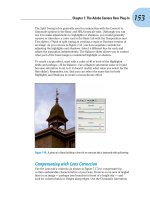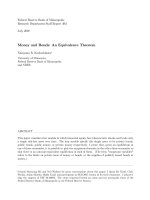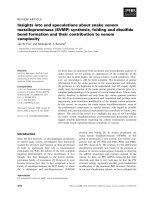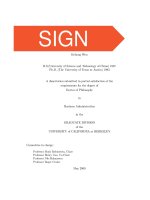Catalytic intramolecular carbene transfer reactions into σ and π bonds
Bạn đang xem bản rút gọn của tài liệu. Xem và tải ngay bản đầy đủ của tài liệu tại đây (14.77 MB, 191 trang )
Catalytic Intramolecular Carbene Transfer Reactions into
σ and π Bonds
(σ及びπ結合への触媒的分子内カルベン移動反応)
March, 2020
Doctor of Philosophy (Engineering)
PHAN THI THANH NGA
ファン ティ タン ガ
Toyohashi University of Technology
ACKNOWLEDGEMENTS
First and foremost, I would like to express my deep thanks to my supervisor, Professor Dr.
Seiji Iwasa, for everything he did for me during my study within four years. Actually, there is no
words can express my deep sense of gratitude towards him. I would like to thanks him for his
endless support, encouragement, advices and patience throughout my PhD work.
I would like to express Prof. Dr. Kazutaka Shibatomi for his investing time and providing
interesting and valuable feedback throughout my research period.
And I would like to thank to my doctoral committee members, Prof. Dr. Shinichi Itsuno
for his valuable suggestions.
I am thankful for Dr. Ikuhide Fujisawa for his hospitality and for assisting me with the Xray measurements. I am very grateful to Mr. Masaya Tone, Mr. Hayato Inoue, Ms. Huong for their
cooperation, suggestion, and valuable discussion throughout my research period.
I also would like to acknowledge all the labmates whom I had the pleasure of working
with: Dr. Soda, Dr. Hamada, Dr. Kotozaki, Dr. Nakagawa, Dr. Chi, Ms. Doan, Mr. Augus, Mr.
Liang, Mr. Fujii, Mr. Fukuda, Ms. Nansalmaa, Ms. Matozaki, Mr. Ogura, Mr. Yamaguchi, Ms.
Linhda, Ms. Zolzaya and all other research scholars of the department who have been very friendly
and helped me in various ways.
I acknowledge all the staff members of the international and educational affairs division at
Toyohashi University of Technology for their support during the progress of my graduation steps.
I would like to thank all the friends that I have met in Toyohashi: Mona, Hằng, Huế, Bảo,
Trinh, Hường, Khơn, Hồi. I really cherish the great time we spent together: the dinner parties,
summer barbecues, autumn red leaves, skiing and Tết.
With my appreciation and respect, this work would not have been possible without the
financial support of the Hitachi Global Foundation, they gave me the chance to study in Japan
under their financial support to my work.
I want to thank all the staffs of Faculty of Chemical Engineering, HCMC University of
Technology for their supports in the fulfilment of my PhD program. I also acknowledge Prof. Le
Thi Kim Phung – director external relations office of HCMC University of Technology for her
support and encouragement.
i
My deepest gratitude is reserved for my family, for having filled my life with every joy,
helping me to get through so many gloomy days and lighting up every last corner. For my parents,
my brother Ấn who have always been there for me. Needless to say, they have helped
immeasurably to get me to this point in my life.
Thank you very much!
PHAN THI THANH NGA
Department of Applied Chemistry and Life Science
Toyohashi University of Technology, 1-1 Tempaku-cho,
Toyohashi, Aichi 441-8580 (Japan)
E-mail:
ii
ABSTRACT
Keywords: asymmetric synthesis, cyclopropanation, Buchner reaction, Ru(II)-Pheox catalyst.
A carbene known as a most active intermediate is complexed with a transition metal, which
affords the corresponding metal-carbene complex and catalytically inserts into σ and π bonds of
the organic compound. Even though there are many reports on the carbene transfer process to
develop a new approach for the synthesis of medicine and other bioactive compounds, the regio-,
stereo- and chemoselective approaches are still limited and remained as the main subject in the
field of synthetic organic chemistry. For this background, I developed an efficient catalytic
intramolecular carbene transfer reactions by using originally developed ruthenium catalyst into σ
and π bonds and successfully applied for the synthesis of γ-lactam ring fused aromatics (oxindoles),
γ-lactone ring fused cyclopropanes, and γ-lactam ring fused seven-membered rings via Buchner
reaction.
Although the ruthenium complex is a newcomer in the field of catalytic carbene transfer
reaction, it has emerged as a useful transition metal for the carbenoid chemistry of diazo
compounds, besides copper and rhodium. And recently, we have developed a Ru(II)-Pheox
complex, which is efficient for carbene transfer reactions, in particular, asymmetric
cyclopropanation, N-H insertion, C-H insertion and Si-H insertion reactions.
Therefore, driven by my interests in the catalytic asymmetric carbene transfer reaction and
the efficiency displayed by the Ru(II)-Pheox catalyst, I started to explore the asymmetric
cyclopropanation, C-H insertion, Buchner reactions of various diazo compounds, which are
potentially building blocks and expectant to be applied in pharmaceutical and medicinal fields.
In my thesis, Chapter 1 describes the importance of carbene transfer reactions. And a short
review of the metal carbene intermediates in C-H insertion, asymmetric cyclopropanations, and
Buchner reaction have been also illustrated in this chapter. In addition, the application of metal
carbene complexes in the synthesis of biologically-active or natural product-like compounds is
also mentioned.
Chapter 2 is for the synthesis of oxindoles. The oxindole ring is prevalent as an important
scaffold found in numerous natural products and pharmaceutically active compounds. Over the
past few decades, the emerging therapeutic potential of the structural motif of oxindole has
encouraged the medicinal chemists to synthesize novel oxindole derivatives. I report Ru(II)-Pheox
iii
was found to be a highly efficient catalyst for the synthesis of oxindole derivatives in excellent
yields. We developed the efficient synthesis of oxindole derivatives via intramolecular ArCsp2-H
insertion reaction of diazo acetamides derived from the corresponding anilines by using Ru(II)Pheox catalyst. The reaction proceeds smoothly under mild conditions, providing the
corresponding oxindole derivatives in excellent yield (up to 99%). No other side reactions related
to metal-carbene reactivity such as dimerization, aromatic ring expansion and Csp3-H on amide
nitrogen insertion reaction were observed.
On the other hand, the cyclopropane subunit is also present in many biologically important
compounds and it shows a large spectrum of biological properties. Transition metal-catalyzed
cyclopropanation involving carbene intermediate is powerful and useful methods for constructing
important substructures of targeted molecules, and therefore they have been extensively studied
for the past couple of decades. Thus, Chapter 3 presents the development of asymmetric catalysts
based on Ru(II)-Pheox complexes, I developed a new series of Ru-Colefin(sp2) bond-containing
organometallic complexes and successfully applied them to the catalytic asymmetric inter- and
intramolecular cyclopropanations, which are carbene transfer reaction. It is noteworthy that high
yields and stereoselectivity were achieved for trans-cyclopropane carboxylates even with a low
catalyst loading. Catalytic asymmetric cyclopropanations of diazoesters with olefins in the
presence of the Ru-Colefin(sp2)-phenyloxazoline complexes proceeded smoothly to give the
corresponding optically active cyclopropanes in high yields, with a trans/cis ratio 97/3 to >99/1
and 97% to >99% ee (trans). The enantioselectivities were affected by the geminal substituent on
the Ru-Colefin (sp2) bond; the highest enantioselectivities were obtained when using Ru(II)-Prox
catalyst with no substituent at the germinal position of the metal.
Furthermore, medium ring-containing organic molecules, such as seven-membered rings,
are also the cornerstone of many bioactive natural compounds such as guaiane sesquiterpenes,
guaianolide sesquiterpene lactones. However, there are few reports on their synthesis. Thus, the
development of an efficient method to prepare these scaffolds has attracted a significant amount
of research attention. This unique strategy toward seven-membered carbocycles has been utilized
in natural product synthesis. In Chapter 4, I report the development of an intramolecular Buchner
reaction of a variety of N-benzyl diazoamide derivatives in the presence of a chiral Ru(II)–Pheox
catalyst. The aromatic rings are converted into the corresponding γ-lactam ring fused sevenmembered ring system with high regio- and stereoselectivity. A variety of γ-lactam fused 5,7iv
bicyclic-heptatriene derivatives have been prepared from diazoacetamides in up to 99% yield with
high enantioselectively (up to 99% ee) using a chiral Ru(II)-Pheox catalyst under mild reaction
conditions.
In conclusion, Chapter 5, the Ru(II)−Pheox catalyzed C-H insertion reaction and
asymmetric Buchner reaction proved to be the efficient and straightforward methods for the
preparation of oxindole and seven-membered ring which are important intermediates in the
synthesis of many biologically active compounds. Moreover, we have successfully designed and
synthesized a novel Ru-Prox type catalyst. This catalyst showed excellent reactivities and
selectivities in asymmetric cyclopropanation reactions. And it is expected to provide many further
opportunities in asymmetric catalysis.
And in Chapter 6, all the experimental and analytical data as the evidence for Chapter 2
to 4 are described.
v
ACKNOWLEDGEMENTS……………………………………………………….....…
i
ABSTRACT………………………………………………………………………....…..
iii
LIST OF SCHEMES………………………………………………………….……...…
x
LIST OF FIGURES……………………………………………………………..………
xii
LIST OF TABLES……………………………………………………………..……..…
xiii
LIST OF ABBREVIATIONS……………………………………………………....…..
xiv
NOTATIONS…………………………………………………………………….…..….
xv
CHAPTER 1: Introduction
1.1. Carbenes………………………………………………………………………….…
1
1.1.1.
The history of carbenes…………………………………..………..……........
1
1.1.2.
Carbene-metal bond formation…………………………………………...…
3
1.1.3.
Fischer carbene complexes……………………………………….…..…...…
3
1.1.4.
Schrock carbene complexes…………………………..……………..…….…
4
1.1.5.
Generation of carbene…………………………..………..…………..………
5
1.2. Diazocarbonyl compounds…………………………..……………………….....…...
5
1.2.1.
Properties of α-diazo carbonyl compounds……………………………..……
5
1.2.2.
Reactivity of α-diazo carbonyl compounds……………….…………….……
6
1.3. Transition-metal-catalyzed aromatic C-H insertion reactions……………..........…..
8
1.3.1.
Intermolecular aromatic C-H insertion reactions...…….............……………
8
1.3.2.
Intramolecular aromatic C-H insertion reactions………...……..…..…….…
9
1.4. Cyclopropanations ……..............................................................................................
11
1.4.1.
Simmons–Smith cyclopropanation…………...…………………...….…...…
11
1.4.2.
Transition-metal-catalyzed decomposition of diazoalkanes..……….……….
12
1.4.2.1.
Cobalt.....……..……………...………………………………..…..
13
1.4.2.2.
Copper …………....……..…………………..……..…..……..…..
14
1.4.2.3.
Rhodium ………....……..………………..………...…..……....…
17
1.4.2.4.
Ruthenium....………..…………..…...………………………....…
19
1.5. Buchner reaction…...……………………………..……..……………………...……
23
1.5.1.
The history of Buchner reaction…………………………..……………….…
23
1.5.2.
Transition-metal-catalyzed intramolecular Buchner reaction………….……
25
vi
1.5.2.1.
Buchner reaction vs C-H insertion.....……..……..…...……..……
25
1.5.2.2.
Rhodium catalyzed intramolecular Buchner reaction…………..…
26
1.5.2.3.
Copper catalyzed intramolecular Buchner reaction…………….…
28
Synthesis bioactive compounds by intramolecular Buchner reaction………..
29
1.6. Research objectives..………………………………………………..……...………..
31
1.5.3.
CHAPTER 2: Highly efficient synthesis of oxindole derivatives via catalytic intramolecular
C-H insertion reactions of diazoamides
2.1. Introduction..…...…….…………….....………………………...…..…….……...….
32
2.2. Results and discussions………………………..…..…..…..…………….………...…
34
2.2.1.
Catalyst loading and solvent screening for catalytic intramolecular C-H
insertion reactions of diazoamides....………………….………….…….……
2.2.2.
35
Ru(II)-pheox catalyzed intramolecular C-H insertion reactions of diazoamides.........…...............…..……..…....……………...………………...........
36
2.3. Conclusion…….............….………………………...…………………….……...…..
39
CHAPTER 3: Synthesis of a new entries of chiral ruthenium complexes containing RuColefin(sp2) bond and their application for catalytic asymmetric cyclopropanation reactions
3.1. Introduction..…...…….………………..……………………….….....………...……
40
3.2. Results and discussions……………………..………..…..………...……..…….....…
42
3.2.1.
Preparing the ruthenium complexes.........…………..……..……………..…
3.2.2.
Ruthenium complexes containing Ru-Colefin(sp2) bond catalyzed inter
molecular cyclopropanation…………………...………….……..….…….…
3.2.2.1
43
The substrate scope for the catalytic intermolecular cyclopropanation reaction....………..………………….......…...……....
3.2.3.
43
Catalyst screening and optimization conditions for the catalytic
intermolecular cyclopropanation.....….....……....…………...……
3.2.2.2.
42
45
Ruthenium complexes containing Ru-Colefin(sp2) bond catalyzed intra
molecular cyclopropanation……………………...………....……………….
3.2.3.1
47
Catalyst screening and optimization conditions for the catalytic
intramolecular cyclopropanation.....………..…….…...…….….....
vii
47
3.2.3.2.
The substrate scope for the catalytic intramolecular cyclo
propanation reaction....………..……….……….…………....……
48
3.3. Conclusion……...................………………………...…………..…………...………
48
CHAPTER 4: Highly stereoselective intramolecular buchner reactions of diazo acetamides
catalyzed by Ru(II)-Pheox complex
4.1. Introduction..…...…………………………..………...…….……...………...………
49
4.2. Results and discussions……………………..………..…..………..……………...…
50
4.2.1.
Catalyst screening for intramolecular asymmetric Buchner reaction……….
50
4.2.2.
Solvent screening for intramolecular asymmetric Buchner reaction............…
52
4.2.3.
Ru(II)-Pheox catalyzed intramolecular Buchner .........……..………….….…
53
4.3. Conclusion……..............….………………………....……...……………….....……
56
CHAPTER 5: Conclusion
57
CHAPTER 6: Experimental analytical data
6.1.
General…….…………………………..………...…...…..……...…..………....……
59
6.2. Experimental analytical data for chapter 2………………...………...…………….…
60
6.2.1.
Procedure for the synthesis of diazoacetamides…………...………...……….
60
6.2.2.
Analytical data for diazoacetamides………………...…...…………………..
60
6.2.3.
General procedure for the intramolecular C-H insertion reaction of diazo
acetamides by using Ru(II)-Pheox catalyst…………………......……………
6.2.4.
64
Analytical data for the intramolecular C-H insertion reaction of diazo
acetamides by using Ru(II)-Pheox catalyst……………………..……………
64
6.3. Experimental analytical data for chapter 3………………...………………..…..……
69
6.3.1.
General procedure for catalytic asymmetric intramolecular cyclopropanation
reaction…………..…………………...…………………….……………..…
6.3.2.
69
Analytical data for asymmetric intermolecular cyclopropanation reaction
products…………………...………………………………….….……..……
69
6.4. Experimental analytical data for chapter 4………...…..….........…..………….…..…
71
6.4.1.
Preparation of diazoacetamides.…………………...…..………….............…
viii
71
6.4.2.
Analytical data for diazoacetamides……………...……..……..….............…
6.4.3.
General procedure for catalytic asymmetric intramolecular Buchner reaction
6.4.4.
72
of diazoacetamides.......………………………...…….…………….……..…
76
Analytical data for asymmetric intramolecular Buchner reaction products…..
76
IR SPECTRAL DATA…………..…………………………..………….……………..…
85
NMR SPECTRAL DATA…………..…………………...…….……………...………..…
98
HPLC DATA…………..………………...……………………………….……………..… 148
REFERENCES…………..…………………...……………...………….……………..…
ix
165
LIST OF SCHEMES
Scheme 1.
Generation of the first stable radical....……………….............…...…………
Scheme 2.
Synthesis of tropolone-derivatives via the insertion of a methylene
2
intermediate.………………………………………………………….…......
2
Scheme 3.
Alkene cyclopropanation via methylene intermediate.....………………..…
3
Scheme 4.
Metal-carbon bonding in Fischer carbene complexes…..………………..…
4
Scheme 5.
Metal-carbon bonding in Schrock carbene complexes..………………..…..
4
Scheme 6.
Generation of carbene....……………………….……………………...……
5
Scheme 7.
The resonance structures of α-diazo carbonyls..……………………….……
6
Scheme 8.
Reactivity of α-diazo carbonyls..…………………....……………..…..……
7
Scheme 9.
Copper-catalyzed intermolecular aromatic substitution reaction…………...
8
Scheme 10. Gold-catalyzed reaction of EDA with toluene……..…………………………
9
Scheme 11. Catalyzed azacycle-directed intermolecular aromatic C-H functionalization..
9
Scheme 12. Rhodium(II)-catalyzed aromatic substitution reactions of α-diazo-β-keto
esters……………………………………..…………………………………... 10
Scheme 13. Titanium BINOLate-catalyzed enantioselective intramolecular aromatic C-H
functionalization……………………………………..………...…………….. 10
Scheme 14. Possible mechanisms for the Simmons–Smith reaction……………..……...
12
Scheme 15. Accepted catalytic cycle for the carbenoid cyclopropanation reaction……..
13
Scheme 16. Mechanism of cobalt-porphyrin catalysis……………..……………………
14
Scheme 17. Copper-bisoxazoline-catalyzed cyclopropanation of some diazoalkanes…..
16
Scheme 18. Cyclopropanation of styryldiazoacetates……………..……………………..
17
Scheme 19. Enantioselective cyclopropanation with α-diazopropionate………………...
18
Scheme 20. Enantioselective synthesis of spirocyclopropyloxindoles…………………..
19
Scheme 21. Asymmetric cyclopropanation catalyzed by a rhodium(I) complex………..
20
Scheme 22. Asymmetric cyclopropanation of 1-tosyl-3-vinylindoles……………….….
21
Scheme 23. Ru(II)-pheox catalyzed asymmetric cyclopropanation of terminal alkenes...
23
Scheme 24. The Buchner reaction.….…....…………………………………….…..……
24
Scheme 25. Predominance of norcaradiene.…………………....……….…….……….…
24
Scheme 26. Stabilization of norcaradiene.…………………....……………….…………
24
Scheme 27. Buchner reaction vs C-H insertion.…………………....………….….…….
25
x
Scheme 28. Copper and rhodium catalyzed intramolecular Buchner reactions….…...…
26
Scheme 29. Rhodium catalyzed intramolecular Buchner reactions…………………..…
26
Scheme 30. Buchner reactions of cyano-substituted diazoketones…………………...…
27
Scheme 31. Enantioselective rhodium-catalyzed intramolecular Buchner reaction……..
28
Scheme 32. Enantioselective Copper-catalyzed intramolecular Buchner reaction….…....
29
Scheme 33. Formal synthesis of (±)-confertin……………………………………..……
30
Scheme 34. Synthesis of harringtonolide……………………………………..…………
30
Scheme 35. Synthesis of gibberellin derivatives……………………………………..…
31
Scheme 36. Transition metal catalyzed C-H insertion reaction of diazoacetamides….…
32
Scheme 37. The efficiency of Ru(II)-Pheox in the synthesis of oxindole derivatives and
their spirocyclopropanation …………………..………………………..……
33
Scheme 38. Intramolecular C-H insertion reaction of diazoacetamide 53g catalyzed by
Ru(II)-Pheox…………………………………………………………………
37
Scheme 39. Plausible mechanism of intramolecular C-H insertion reactions of diazo
amides catalyzed by Ru(II)-Pheox……………..………………………….…. 38
Scheme 40. Procedure for the synthesis of a series of Ru(II) complexes………………..
40
Scheme 41. Synthesis of chiral ruthenium complexes containing Ru-Colefin(sp2) bond…
41
Scheme 42. Planarity of the substituent on β position of Ru-C(sp2) bond……………....
45
Scheme 43. Transition metal catalytic carbene transfer reaction of diazoacetamides…...
49
Scheme 44. Asymmetric intramolecular reaction of diazoacetamides catalyzed by the
Ru(II)-Pheox complex....………………………..………………………….
50
Scheme 45. Asymmetric intramolecular reactions of 2-diazo-N-(4-methoxybenzyl)-N-(4nitrobenzyl)acetamide catalyzed by Ru(II)-Pheox..…………………..…….
54
Scheme 46. Procedure for the synthesis of diazo acetamides……………..……………..
60
Scheme 47. Decomposition of 2-diazo-N-methyl-N-phenylacetamide by Ru(II)-Pheox
complex……………..………………………..………………………..……
64
Scheme 48. Catalytic asymmetric intramolecular cyclopropanation reaction……...........
69
Scheme 49. Synthesis of 2-diazo-N,N-bis(4-methoxybenzyl)acetamide……..…………
71
Scheme 50. Catalytic asymmetric intramolecular Buchner reaction of diazoacetamides..
76
xi
LIST OF FIGURES
Figure 1.
The electronic structure of carbenes……………………………...………….....
1
Figure 2.
Intermediates of α-diazo carbonyls………………………………..………...…
6
Figure 3.
Box ligands’ structures for asymmetric cyclopropane reactions…………...…..
15
Figure 4.
Some natural products prepared by copper-box-catalyzed cyclopropanation….
16
Figure 5.
Chiral dirhodium catalysts for asymmetric cyclopropanations………….……..
17
Figure 6.
Several ruthenium–salen complexes for asymmetric cyclopropanations….…...
21
Figure 7.
1
H-NMR spectra of ligand and Ru(II) complex………………………….....…..
42
Figure 8.
X-ray analysis of a novel Ru(II) complexes…………………...…………….…
43
Figure 9.
X-Ray analysis of (S)-6-chloro-2-(4-chlorobenzyl)-3,8a-dihydrocyclohepta
[c]pyrrol-1(2H)-one (51d)……………………………………...…………...…
xii
54
LIST OF TABLES
Table 1.
Mander’s studies of tetralin 2-diazomethyl ketones………………………….
Table 2.
Catalyst screening experiments for Ru(II)-Pheox catalyzed intramolecular CH insertion of 2-diazo-N-phenyl-N-methylacetamide…………………….....
Table 3.
36
Ru(II)-Pheox catalyzed oxindole synthesis of diazoacetamides via intra
molecular C-H insertion of carbene……………………………………..
Table 5.
34
The solvent effect for Ru(II)-Pheox catalyzed intramolecular C-H insertion of
2-diazo-N-phenyl-N-methylacetamide……………………………………….
Table 4.
29
37
Screening of various catalysts and optimization conditions of intermolecular
cyclopropantion reaction………………...……………………………...……
44
Table 6.
Substrate scope of intermolecular cyclopropanation reaction………..........…
46
Table 7.
Screening of various catalysts and optimization conditions of intramolecular
cyclopropantion reaction………………...………………………………...…
47
Table 8.
Substrate scope of intramolecular cyclopropanation reaction………..........…
48
Table 9.
Catalyst screening experiments………………………………………………
51
Table 10.
Efficiency of the Ru(II)-Pheox catalyst………………………………………
52
Table 11.
Optimization of the reaction conditions………………….…………………...
53
Table 12.
Ru(II)-Pheox catalyzed intramolecular Buchner reactions of diazoacetamides.
55
xiii
LIST OF ABBREVIATIONS
Ar
aryl
atm
atmosphere
Bn
benzoyl
Bu
butyl
Calcd
calculated
Conc.
concentrated
d
doublet
dd
doublet of doublet
DFT
density functional theory
dr
diastereomeric ratio
dt
doublet of triplet
EDA
ethyl diazo acetate
ee
enantiomeric excess
EDG
electron-donating group
EPR
electron paramagnetic resonance technique
equiv.
equivalent
ESI-MS
electrospray ionization – mass spectrometry technique
Et
ethyl
Et3N
triethyl amine
EtOAc
ethyl acetate
EWG
electron-withdrawing group
g
gram
h
hour
HPLC
high performance liquid chromatography
Hz
hertz
iPr
isopropyl
IR
infrared
m
multilplet
M
molar
Me
methyl
xiv
mg
milligram
MHz
megahertz
min
minute
mL
milliter
mmol
millimole
Mp
melting point
NMR
nuclear magnetic resonance
Ph
phenyl
ppm
parts per million
q
quartet
Rf
retention factor (in chromatography)
rt
room temperature
s
singlet
t
triplet
tBu
tertiary butyl
td
triplet of douplet
temp.
temperature
tert
tertiary
THF
tetrahydrofuran
TLC
thin layer chromatography
TMS
tetramethylsilane
tR
retention time
U.V
ultra violet
NOTATIONS
α
alpha
[𝛂]𝐃
specific rotation
1
proton nuclear magnetic resonance spectroscopy
H NMR
13
C NMR
19
F NMR
carbon nuclear magnetic resonance spectroscopy
flourine nuclear magnetic resonance spectroscopy
xv
31
P NMR
phosphorus nuclear magnetic resonance spectroscopy
Å
Angstrom (10−10 m)
β
beta
%
percentage
J
coupling constant
[M + H]+
protonated molecular ion (mass spectrometry)
chemical shift
o
degree Celsius
C
xvi
CHAPTER 1
Introduction
1.1 Carbenes
Carbene is a neutral and divalent carbon active species. The general formula is R-(C:)-R'
or R=C:. The term "carbene" may also refer to the specific compound H2C:, also called methylene,
the parent hydride from which all other carbene compounds are formally derived. Carbenes are
classified as either singlets or triplets, depending upon their electronic structure. If the non-bonding
electrons have parallel spins, it is the singlet carbene while the non-bonding electrons have parallel
spins in different orbitals, it is the triplet carbene.
Figure 1. The electronic structure of carbenes.
Triplet carbenes are paramagnetic and may be observed by electron spin resonance
spectroscopy if they persist long enough. Bond angles are 125-140° for triplet methylene and 102°
for singlet methylene. Triplet carbenes are generally stable in the gaseous state, while singlet
carbenes occur more often in aqueous media (Figure 1). For simple hydrocarbons, triplet carbenes
usually have energies 8 kcal/mol (33 kJ/mol) lower than singlet carbenes (see also Hund's rule of
maximum multiplicity), thus, in general, the triplet is the more stable state (the ground state) and
singlet is the excited state species. Substituents that can donate electron pairs may stabilize the
singlet state by delocalizing the pair into an empty p-orbital. If the energy of the singlet state is
sufficiently reduced it will actually become the ground state.
1.1.1. The history of carbenes
In 1885, the first assumption of a carbene species was reported by Geuther and Hermann.[1]
They suggested that the alkaline hydrolysis of chloroform proceeds though the formation of a
reaction intermediate with a divalent carbon called dichlorocarbene. In 1897, Nef proposed the
same reaction intermediate for the Reimer–Tiemann reaction and the transformation of pyrrol to 1
chloropyridine in chloroform[2]. They both showed a lot of intuition and courage for their
postulations considering that most chemists did not even believe in the existence of free radicals
at that time.
Indeed, it was only 3 years later that Gomberg characterized the first example of a free
radical, triphenylchloromethylene 2 (Scheme 1), through elemental analysis and chemical
reactivity[3]. Its discovery was freshly welcomed by the scientific community[4]. Prior to the Great
War, Staudinger and Kupfer contributed to the recognition of carbenic reaction intermediates by
studying the formation of methylene derivatives[5] and diazomethane[6].
Scheme 1. Generation of the first stable radical.
Throughout the 1920s and 1930s, the existence of free radicals was finally well recognized,
and their use in organic chemistry as reaction intermediates was growing extremely rapidly[4]. In
this context, carbene moieties were regarded as diradicals[7]. The methylene carbene was seen as
a linear species, with two degenerate p-orbitals inevitably leading to a triplet state[8]. At the
beginning of the 1950s, there was a resurgence of interest in the organic chemical reactions of
carbenes[9]. In 1953, Doering and Knox disclosed an elegant synthesis of tropolones 3 via an
addition of methylene to substituted benzene (Scheme 2)[10].
Scheme 2. Synthesis of tropolone-derivatives via the insertion of a methylene intermediate.
2
The most important contribution of Doering and his collaborators came a year later when
they proved the existence of a dibromomethylene intermediate 5, in the first cyclopropanation
product 6 operating via the addition of bromoform to an alkene 4 (Scheme 3)[11].
Then more organic synthesis involving the use of methylene were reported[12], prompting
chemists and physicists to have a closer look at this carbenic intermediate.
Scheme 3. Alkene cyclopropanation via methylene intermediate.
1.1.2. Carbene–metal bond formation
The formation of the C–M bond of a carbene–metal complex by orbitals overlapping
requires a narrowing of the valence angle (XCY) at the carbene center [13]. Carbenes stabilized by
the donation from both -groups (+M/+M), such as diaminocarbenes or dialkoxycarbenes, adopt a
bent geometry with a small valence angle at the central carbon
[14]
. They have the required
geometry to strongly and easily bind a metal fragment. In contrast push–pull carbenes, alkylidenes,
and triplet carbenes adopt a widened valence angle and tend to be linear
[14]
. They do not have
adequate geometry to bind the metal fragment and any changes of conformation to narrow their
valence angle are energetically unfavorable
[13]
. Consequently, they are very reluctant to form a
metal complex and give a weaker metal–carbon bond.
1.1.3. Fischer carbene complexes
Well-stabilized heteroatomcontaining singlet carbenes, such aminocarbenes, and
alkoxycarbenes have a significant gap between their singlet and triplet ground states
[15]
. They
form a metal–carbon bond constituted by mutual donor–acceptor interaction of two closed-shell
(singlet) fragments. The dominant bonding arises from carbene–metal π-donation and
simultaneously from metal–carbene π-back donation (Scheme 4) [16].
3
Scheme 4. Metal–carbon bonding in Fischer carbene complexes.
The π-electrons are usually polarized toward the metal and the carbon–metal bond has a
partial double bond character, which diminishes with the stabilization of the carbene by its -groups
[16, 17]
. For instance, in diaminocarbenes, including NHCs, the metal–carbon bond is seen as a
simple bond; the π-back donation is usually weak because the carbenic carbon is already well
stabilized by π-donation from its amino-groups [18, 19]. Fischer carbene complexes are electrophilic
at the carbon–metal bond and are prone to nucleophilic attack at the carbene center (OMe/NMe2
exchange for instance) [13, 16, 18]. They are associated with low oxidation state metals [16, 18, 19].
1.1.4. Schrock carbene complexes
Scheme 5. Metal–carbon bonding in Schrock carbene complexes.
Poorly stabilized carbenes such as dialkylcarbenes or alkylidenes have a small gap between
their singlet and triplet ground state. They form a covalent metal–carbon bond in nature created by
the coupling of two triplet fragments (Scheme 5)
[13b, 20]
. The π-electrons are nearly equally dis
tributed between the carbon and the metal, and the metal–carbon bond is seen as a true double
bond.[16,
20]
Schrock carbene complexes are nucleophilic at the carbon–metal bond and are
susceptible to react at the carbene center with electrophiles as in a Wittig reaction involving a ylide
4
instead of a carbene.[18] They are found exclusively among early transition metals with the highest
oxidation state.[16]
1.1.5. Generation of carbene
A method that is broadly applicable to organic synthesis is induced elimination of halides
from gem-dihalides employing organolithium reagents. It remains uncertain if under these
conditions free carbenes are formed or metal-carbene complex. Nevertheless, these
metallocarbenes (or carbenoids) give the expected organic products.
Scheme 6. Generation of carbene.
For cyclopropanations, zinc is employed in the Simmons–Smith reaction. In a specialized
but instructive case, alpha-halomercury compounds can be isolated and separately thermolyzed.
Most commonly, carbenes are generated from diazoalkanes, via photolytic, thermal, or transition
metal-catalyzed routes. Catalysts typically feature rhodium and copper.
1.2. Diazocarbonyl compounds
The chemistry of diazocarbonyl compounds has a long history.[22] It has attracted the
researchers owing to their diverse applications in organic synthesis. Curtius reported the first
synthesis of α-diazo carbonyl compound in 1883. It involved the diazotization of the natural αamino acid Glycine to give ethyl diazoacetate. In 1912, Wolff discovered the well-known
rearrangement that bears his name, ‘Wolff Rearrangement’. But, the availability of a wide range
of diazo compounds came about as a result of the works of Arndt and Eistert and Bradley and
Robinson. Since then, the diazo moiety has become very popular.
1.2.1. Properties of α-diazo carbonyl compounds
In 1935, Boetsch did an electron diffraction experiment, and in 1957, Clusius proceeded a
subsequent labeling experiment. They proved that the correct structure for aliphatic diazo
5
compounds is the linear structure.[22] The bonding structure of α-diazo carbonyls is described by
the resonance structures shown in Scheme 7.
Scheme 7. The resonance structures of α-diazo carbonyls.
Most aliphatic diazo compounds have yellow to red color and absorb strongly in the IR
region from 1950 to 2300 cm-1 which is assigned to the N-N stretching mode. In 13C NMR spectra,
the signal for the diazo carbon of diazomethane appears at δ = 23.1 ppm relative to TMS, whereas
for α-diazo carbonyl compounds the diazo carbon signal is shifted downfield.[23]
In general, the thermal stability of diazo compounds varies very much with substituents
attached to the diazo group. Substituents with electron acceptor ability make α-diazo carbonyl
compounds less thermally stable via stabilizing the resonance contributing structure (Scheme 7)
through delocalization of the charge and hence favoring the nitrogen elimination.
1.2.2. Reactivity of α-diazo carbonyl compounds
Reactions of diazo carbonyl compounds proceed via thermal, photochemical or catalytic
expulsion of nitrogen (-N2), which will lead to give different types of reactive intermediates. For
example, free carbenes, metal carbenoids, carbonyl ylides, and diazonium ions (Figure 2).
Figure 2. Intermediates of α-diazo carbonyls.
These reactive intermediates lead to a wide variety of reactions, which can be organized
into the following categories: 1,3-dipolar cycloaddition reactions of the diazo group, [3+2]
cycloaddition reactions of carbonyl ylides from carbene intermediates, cyclopropanations,
6
aromatic cycloadditions, insertion into X-H (X = C, O, S, N) bonds, Wolff rearrangements, ylide
formation and its subsequent reactions, α,α-substitution reactions and oxidation of the α-diazo
group (Scheme 8).[22c]
Scheme 8. Reactivity of α-diazo carbonyls.
7
Catalytic aromatic cycloaddition and cyclopropanation reactions of α-diazo carbonyl
compounds will be explained in detail since they relate to the chemistry to be discussed in this
dissertation.
1.3. Transition–metal–catalyzed aromatic C−H insertion reactions
Reactions of α-diazo carbonyl compounds with aromatic substrates leading to aromatic
substitution products is a significant pathway which, depending on the substrate structure, can
compete effectively with the aromatic cycloaddition process. In some cases, exclusive aromatic
substitution is observed, while in other mixtures of products are formed. Although incorrectly
termed C−H insertion, the process differs mechanistically from aliphatic C−H insertion in that
aromatic C−H insertion is believed to involve the formation of a zwitterionic intermediate from
electrophilic addition of a metal carbene to the aromatic ring and a subsequent rapid proton
transfer.[46, 47]
These types of reactions, which can proceed both in an intermolecular and in an
intramolecular fashion, are a powerful synthetic tool by which C−C bonds can be formed between
two sp2-hybridized carbons under relatively mild conditions. These reactions have been
traditionally carried out in the presence of a transition metal catalyst, usually, rhodium or copper.
1.3.1. Intermolecular aromatic C−H insertion reactions
The area of intermolecular aromatic substitution has received increased attention in recent
years. In there, gold, copper, and rhodium complexes have emerged as potentially useful catalysts
for intermolecular aromatic substitution reactions.[49−52]
Scheme 9. Copper-Catalyzed Intermolecular Aromatic Substitution Reaction.
Tayama and coworkers reported high yields in the intermolecular reactions of α-diazoesters
with N,N-disubstituted anilines (Scheme 9).[48] Reactions were carried out in the presence a range
8









